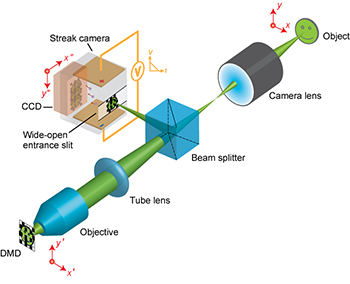
System configuration for compressed ultrafast photography, including the digital micromirror device (DMD). Credit: L. Gao et al. Washington University in St. Louis, USA
What does an ultrashort laser pulse look like as it bounces off a mirror? A new ultrafast camera system can capture 2-D image sequences of such fleeting phenomena at up to 100 billion frames per second (fps).
Researchers in OSA Fellow Lihong Wang's group at Washington University in St. Louis (USA) developed a receive-only technique called compressed ultrafast photography, which does not require specialized active illumination schemes (Nature, doi:10.1038/nature14005). The imaging technique lends itself to luminescent subjects, potentially ranging from the nanoscale to the astronomical scale.
Electronic imaging devices can grab up to 10 million fps, but the on-chip storage and readout speeds of charge-coupled devices and complementary metal-oxide semiconductors fundamentally limit higher frame rates. Another ultrafast image recorder, the streak camera, records information only in one dimension and thus cannot produce conventional 2-D “moving pictures.”
In compressed ultrafast photography, a beam splitter first sends light from the object being imaged to a digital micromirror device (DMD), which encodes the spatial domain with pseudo-random binary information. The DMD—the core technology in today's digital projectors—is an array of about 1 million moving mirrors, each a few microns across. Light reflected by the DMD goes back to the beam splitter and is passed to a streak camera, which temporally disperses and records the image information on a CCD. Computer algorithms then reconstruct the data to form a “motion picture.”
To demonstrate how the system could record events happening over a few tens of picoseconds, the researchers “filmed” single laser pulses reflecting off a mirror, refracting when passing from one medium to another, and moving at different speeds within two media. (A bit of evaporated dry ice in the air and zinc oxide in the resin scattered enough light through the media to make photography of the pulses possible.) These demonstrations of basic optical principles happen in about 200 to 300 ps; when these 5 x 1010 fps images are played back at video speeds, they show the pulses appearing to move at ultraslow speeds. The videos can be viewed here: http://ow.ly/FGOxg.
The researchers predict that the compressed ultrafast photography system could be coupled to both microscopes and telescopes for recording a variety of subjects, ranging from the lifetimes of fluorescent proteins in living cells to fast-moving space junk and near-Earth asteroids.
